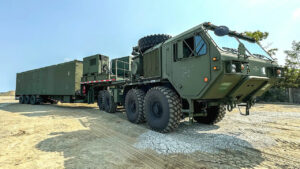THE PHILIPPINES is considering all security options that would deter Chinese aggression in the South China Sea, after the US said it does not plan on pulling out its missile system it left in Manila, according to the country’s Defense chief.
“Whatever will serve our deterrent purpose for our national defense, of course that is open for consideration,” Defense Secretary Gilberto Eduardo Gerardo C. Teodoro, Jr. told reporters on the sidelines of a Senate hearing on his agency’s budget for 2025.
Washington has no plans to withdraw its Typhon missile system from the Philippines and is studying its use in a regional conflict, Reuters earlier reported.
China and Russia have criticized the move, saying it could fuel an arms race in the region.
“Why don’t they look at their own offensive missile capabilities and remove them, destroy their nuclear weapons and get out of the West Philippine Sea?” Mr. Teodoro said. “Why are they picking on a country which is seeking to strengthen its credible deterrent posture?”
The Chinese Embassy in Manila did not immediately reply to a Viber message seeking comment.
The US Army flew the Typhon, which can launch missiles including SM-6 missiles and Tomahawks with a range exceeding 1,600 kilometers (994 miles), to the Philippines in April in what it called a “historic first” and a “significant step in our partnership with the Philippines.”
The Philippines is open to acquiring the Typhon midrange missile system, Agusan del Norte Rep. Jose “Joboy” S. Aquino II said last week, as he sponsored the 2025 budget of the Defense department.
But there was no offer yet from the Philippines to buy the missile system and it is not included in the Defense department’s military modernization wish list that will be funded by standby funds in the 2025 national budget, he told the House of Representatives plenary.
The Chinese Foreign Ministry has said Manila and its allies ganging up on Beijing would only worsen tensions and destabilize the region.
Manilla, Washington, Ottawa and Canberra held their first joint military exercises in the South China Sea on Aug. 7 and 8 amid Beijing’s increased military buildup in the waterway.
The United States, a treaty ally of the Philippines, has held similar exercises with other countries in the disputed water, having carried out drills with Manila and Tokyo in June.
The Philippines and China have resumed diplomatic talks on how to ease tensions, even as both sides insisted on upholding their sovereign rights over features in the South China Sea.
The two nations have traded accusations of intentional ramming of each other’s vessels in a series of clashes last month, just after reaching a pact on resupply missions to a beached Filipino naval ship at Second Thomas Shoal.
Philippine Foreign Affairs Secretary Enrique A. Manalo has said Manila does not want to gang up on China with the international community, as it considers bringing the sea dispute to the United Nations General Assembly.
“So, if they’re throwing stones right now, let them remove their nuclear arsenal, withdraw from places that they are not supposed to be,” Mr. Teodoro said.
“How can a country, which is seeking to protect its exclusive economic zone from unlawful aggression, be a cause of instability in the Indo-Pacific, [if it] does not have offensive nuclear weapon capabilities, has not reclaimed islands and has not claimed a non-dash line which is illegal and absurd?” he added.
Mr. Manalo in July assured his Chinese counterpart that the presence of the missile system in his country posed no threat to China and would not destabilize the region.
China has fully militarized at least three of several islands it built in the South China Sea, which it mostly claims in full despite a 2016 arbitral ruling that backed the Philippines, arming them with anti-ship and anti-aircraft missiles, the US has said.
China says its military facilities in the Spratly Islands are purely defensive, and that it can do what it likes in its own territory.
China claims almost the entire South China Sea, including parts claimed by the Philippines, Brunei, Malaysia, Taiwan and Vietnam.
Portions of the waterway, where $3 trillion worth of trade passes yearly, are believed to be rich in oil and natural gas deposits, as well as fish stocks. — John Victor D. Ordoñez
